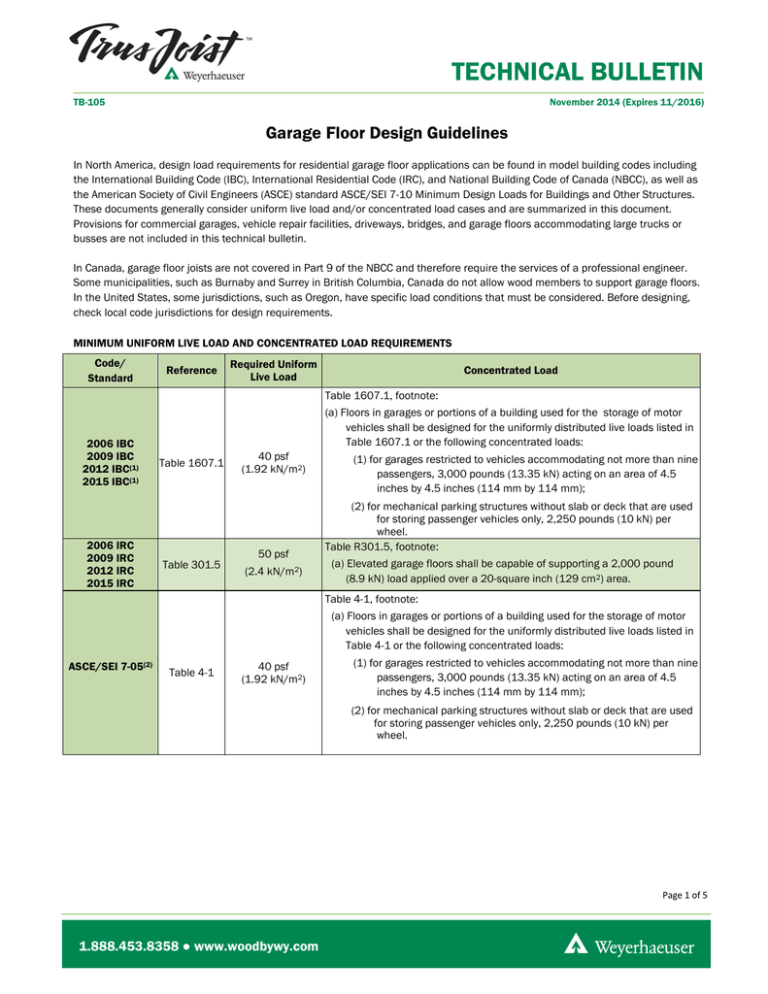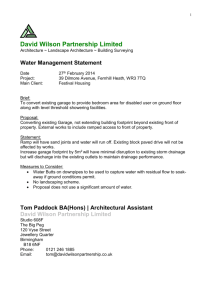
TECHNICAL BULLETIN
TB-105
November 2014 (Expires 11/2016)
Garage Floor Design Guidelines
In North America, design load requirements for residential garage floor applications can be found in model building codes including
the International Building Code (IBC), International Residential Code (IRC), and National Building Code of Canada (NBCC), as well as
the American Society of Civil Engineers (ASCE) standard ASCE/SEI 7-10 Minimum Design Loads for Buildings and Other Structures.
These documents generally consider uniform live load and/or concentrated load cases and are summarized in this document.
Provisions for commercial garages, vehicle repair facilities, driveways, bridges, and garage floors accommodating large trucks or
busses are not included in this technical bulletin.
In Canada, garage floor joists are not covered in Part 9 of the NBCC and therefore require the services of a professional engineer.
Some municipalities, such as Burnaby and Surrey in British Columbia, Canada do not allow wood members to support garage floors.
In the United States, some jurisdictions, such as Oregon, have specific load conditions that must be considered. Before designing,
check local code jurisdictions for design requirements.
MINIMUM UNIFORM LIVE LOAD AND CONCENTRATED LOAD REQUIREMENTS
Code/
Standard
Reference
Required Uniform
Live Load
Concentrated Load
Table 1607.1, footnote:
2006 IBC
2009 IBC
2012 IBC(1)
2015 IBC(1)
2006 IRC
2009 IRC
2012 IRC
2015 IRC
(a) Floors in garages or portions of a building used for the storage of motor
vehicles shall be designed for the uniformly distributed live loads listed in
Table 1607.1 or the following concentrated loads:
Table 1607.1
Table 301.5
40 psf
(1.92 kN/m2)
50 psf
(2.4 kN/m2)
(1) for garages restricted to vehicles accommodating not more than nine
passengers, 3,000 pounds (13.35 kN) acting on an area of 4.5
inches by 4.5 inches (114 mm by 114 mm);
(2) for mechanical parking structures without slab or deck that are used
for storing passenger vehicles only, 2,250 pounds (10 kN) per
wheel.
Table R301.5, footnote:
(a) Elevated garage floors shall be capable of supporting a 2,000 pound
(8.9 kN) load applied over a 20-square inch (129 cm2) area.
Table 4-1, footnote:
(a) Floors in garages or portions of a building used for the storage of motor
vehicles shall be designed for the uniformly distributed live loads listed in
Table 4-1 or the following concentrated loads:
ASCE/SEI 7-05(2)
Table 4-1
40 psf
(1.92 kN/m2)
(1) for garages restricted to vehicles accommodating not more than nine
passengers, 3,000 pounds (13.35 kN) acting on an area of 4.5
inches by 4.5 inches (114 mm by 114 mm);
(2) for mechanical parking structures without slab or deck that are used
for storing passenger vehicles only, 2,250 pounds (10 kN) per
wheel.
*
1.888.453.8358 ● www.woodbywy.com
Page 1 of 5
TECHNICAL BULLETIN
TB-105
November 2014 (Expires 11/2016)
MINIMUM UNIFORM LIVE LOAD AND CONCENTRATED LOAD REQUIREMENTS (CONTINUED)
Code/
Standard
Reference
Required Uniform
Live Load
Concentrated Load
Table 4-1, footnote:
(a) Floors in garages or portions of a building used for the storage of motor
vehicles shall be designed for the uniformly distributed live loads of Table 4-1
or the following concentrated loads:
ASCE/SEI 7-10(3)
Table 4-1
40 psf
(1.92 kN/m2)
(1) for garages restricted to vehicles accommodating not
more than nine passengers, 3,000 pounds (13.35 kN)
acting on an area of 4.5 inches by 4.5 inches
(114 mm by 114 mm); and
(2) for mechanical parking structures without slab or deck that are
used for storing passenger vehicles only, 2,250 pounds (10 kN)
per wheel.
2005 NBCC
Section 4.1.5.10:
- Floor used by passenger cars:
Table 4.1.5.3 For Passenger Cars Load = 2,480 lbs. (11 kN)
Section
LL = 50 psf (2.4 The specified live load due to possible concentrations of load resulting from
4.1.5.10
the use of an area of floor or roof shall not be less than that listed in Table
kPa)
4.1.5.10. applied over an area of 29.5 inches by 29.5 inches (750 mm by
750 mm) located so as to cause maximum effects.
2010 NBCC
Vehicles not
exceeding
8,820
Table 4.1.5.3
lbs (4,000 kg)
Section
4.1.5.10
LL = 50 psf (2.4
kPa)
Section 4.1.5.9:
- Floors used by vehicles not exceeding 8,820 lbs (4,000 kg):
Load = 4,046 lbs. (18 kN)
Loaded Area = 4.72 inches by 4.72 inches (120 mm by
120 mm)
(1) The 2012 & 2105 IBC prohibits live load reductions for garage floors except for members supporting two or more floors (see Section 1607.10.1.3).
(2) The ASCE/SEI 7-05 prohibits live load reductions for garage floors except for members supporting two or more floors (see Section 4.7.4).
(3) The ASCE/SEI 7-10 prohibits live load reductions for garage floors except for members supporting two or more floors (see Section 4.8.3).
*
1.888.453.8358 ● www.woodbywy.com
Page 2 of 5
TECHNICAL BULLETIN
TB-105
November 2014 (Expires 11/2016)
Design Considerations
When checking concentrated loads, the uniform live load is removed and replaced with a single concentrated point load to simulate
a jack load. The majority of a vehicle's weight (80%) is in the engine. The concentrated load provision of 40% of the gross vehicle
weight contained in codes prior to 2003 stems from the weight of the engine supported on two wheels. The minimum load of 2,000
lbs in the IRC is the equivalent of a 5,000-lb automobile. Sport utility vehicles, passenger vans, and light trucks have increased in
size each year. For example, a Chevrolet Suburban weighs approximately 5,700 lbs, while a Ford Excursion weights 7,600 lbs.
Because of these heavier vehicles, the concentrated load of 3,000 lbs in the 2006, 2009 and 2012 IBC and ASCE/SEI 7-05 and 710 is recommended. The designer must ensure that the structure is capable of supporting loads that can be reasonably expected.
In addition, the condition of concentrated or uniform live load which produces the greatest stresses shall govern.
When checking concentrated load requirements, floor joists should be analyzed with as many concentrated loads as are feasible for
the garage, with one concentrated load used for each parking space. Depending on the joist layout and support locations, it may be
possible to have a single joist supporting two parking spaces. Concentrated loads shall be located where they cause the worst
stresses, and will change depending upon the design property. For example, concentrated load locations for determining maximum
bending moment will be different than those for shear, bearing, and deflection.
Weyerhaeuser structural frame software employs safe-load checks for commercial products. The commercial concentrated load
provision (safe-load) in software assumes a single 2,000 lb concentrated load acting over 2½ square feet, which does not comply
with the live load requirements or the appropriate footprint for garage floors. Therefore, safe-load design in Weyerhaeuser software
should not be relied upon to properly size and analyze garage floor joist members.
Keep in mind that a garage floor may have a significant dead load associated with its design. The IBC and IRC have provisions
requiring that floor surfaces be made of a noncombustible material, and many times, the material of choice may be a concrete
topping layer. For more on floor surface requirements, see below.
It is important to use particular caution and judgment when designing garage floors. This is one application that will regularly
support full design live loads.
Finally, a directly applied ceiling will improve the bottom flange stability of garage floor members. If a ceiling finish is directly
fastened to the garage floor joists, it is important to strictly limit live-load deflection to minimize cracking in the ceiling finish. Also,
because of the long-term loads involved, the effects of creep must be considered. Comparably speaking, TJI® joists have relatively
low reaction and shear capacities, so using Trus Joist® Microllam® LVL, TimberStrand® LSL, or Parallam® PSL for garage floor
framing members often provides a better solution.
*
1.888.453.8358 ● www.woodbywy.com
Page 3 of 5
TECHNICAL BULLETIN
TB-105
November 2014 (Expires 11/2016)
Consider 4 load cases for a simple span garage floor to determine member. Whichever load case produces the greater load effect
shall be used to size the supporting member.
Case 1: Uniform live load + Uniform dead load
Case 2: Uniform dead load + live load located
at mid-span (Design professional may design reinforced
concrete, and determine some load sharing for this case)
Case 3: Uniform dead load + pounds live load located
the depth of the joist + ½" from face of bearing.
(no load sharing this case)
Case 4: Bearing Length/Hanger Check- Uniform dead load
+ live load located ½" from face of bearing
Floor Surface Requirements
As mentioned above, garage floor parking surfaces must be made from noncombustible and nonabsorbent materials. Many times,
a concrete topping layer is used and can significantly add to the dead load of the floor system. Concrete topping layers should be at
least 3 inches thick and reinforced to prevent cracking due to cyclic wheel loads and shrinkage. If a concrete topping layer is used,
then long term loading must be addressed.
IBC, Section 2304.12 addresses long-term loading of wood members. It requires that wood members supporting concrete, masonry,
or similar materials be checked for long-term loading using the provisions of the AF&PA NDS. The total deflection, including the
effects of long-term loading, shall be limited in accordance with Section 1604.3.1 for these supported materials. One exception to
Section 2304.12 is horizontal wood members supporting a masonry or concrete nonstructural floor or roof surfacing not more than
4 inches thick (102 mm), which need not be checked for long-term loading. For more information on long term loading and creep,
see Technical Bulletin, TB-101.
Hanger Considerations
If connection details require hangers to sit on a treated plate on top of the foundation or connect to a treated ledger other than
TimberStrand® StrandGuard® LSL, additional corrosion resistance may be required for the hangers. For additional hanger
information please refer to Simpson Strong-Tie and USP catalogs.
*
1.888.453.8358 ● www.woodbywy.com
Page 4 of 5
TECHNICAL BULLETIN
TB-105
November 2014 (Expires 11/2016)
Sheathing Requirements
In some regions it is not uncommon for builders to prefer building an elevated garage floor over wood framing rather with a
structural concrete slab. While the design of the support joist framing is relatively straightforward, the calculations for garage
flooring materials (wood structural panels covered by other materials) are more complex. Historically, sheathing and panel industry
associations have provided several systems that have been deemed to be adequate in these applications. However, building code
load requirements have significantly increased recently. Therefore, it is Weyerhaeuser's recommendation that users consult with a
registered design professional to provide a site specific design.
Additional Recommendations
Adequate ventilation, drainage, and detailing are necessary to ensure that wood products remain dry, particularly at the interface
between the driveway and the garage. A waterproof membrane should be installed between the sheathing and the concrete topping
layer. In addition, provisions should be made for draining water that might collect on top of the membrane. Moisture conditions
above those at dry-service conditions will increase initial deflection, increase creep deflection due to sustained loads, and reduce
the strength of the wood.
If you have any questions, please feel free to contact your Weyerhaeuser representative.
,’Weyerhaeuser,’Forte,’Javelin,’Microllam,’Parallam,’Silent’Floor,’TimberStrand,’TJI,’TJ,’Trus’Joist,’Edge,’and’Edge’Gold’are’registered’trademarks’and’TJPro’is’a’trademark’of’Weyerhaeuser’NR.’©’2014’Weyerhaeuser’NR’Company.’All’rights’reserved.
1.888.453.8358 ● www.woodbywy.com
Page 5 of 5


